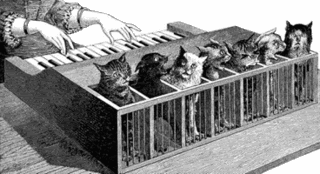It's ironic that the horror genre would be so quiet at the turn of the 21st century. Ironic, because in the years that followed--the final years of this seven-part history of horror--we have seen scary movies hold mainstream America fascinated to a degree greater than anything witnessed before, or at the very least since the heyday of Universal 75 years ago.
Whereas in the past, horror was treated as the forgotten stepchild of the movie biz, the sordid secret kept hidden away and relegated to midnight showings and niche subcultures, these days it's all around us, accepted like never before by a culture which has perhaps become too cynical and overexposed to real-life horrors to truly be shocked any longer. More on that later.
In recent years, the last true example of cinematic dread we've seen has been the surge of unnerving films that have come out of the Far East. In the Western world, the trend became to remake these films for American audiences, starting with The Ring in 2002. By far the most effective of the bunch, it was followed by the likes of The Grudge (2004), and more recently Shutter and The Eye.
Much of what became hip for the genre this decade has had to with a nostalgia for the films of a generation past. In part, this can be pointed to for the dramatic resurgence of the zombie subgenre--it can also be attributed to the success of videogames like Resident Evil. It was that game that kicked off the undead renaissance with a film adaptation in 2002. That same year saw the release of Danny Boyle's 28 Days Later, which introduced us to the concept of "fast-moving zombies."

It might not be an exaggeration to say that the past half-decade has seen more flesh-eater flicks than at any point previous. George Romero's Dawn of the Dead got a surprisingly high quality 2004 remake; Romero himself finally got to continue his saga with 2005's Land of the Dead; and Edgar Wright brought us the ingenious Shaun of the Dead (2004), the finest horror comedy this side of Abbott & Costello Meet Frankenstein.
The other face of this nostalgia was a throwback to the gritty, over-the-top exploitation horror of the 1970s. After more than a decade of restraining itself, Hollywood was starting to let its hair down again. The result is epitomized by the work of rocker-turned-director Rob Zombie, whose House of 1,000 Corpses (2003) and The Devil's Rejects (2005) exemplify a return to the early work of Tobe Hooper and Wes Craven.
But the logical extension of this would turn out to be a development that has been troubling to some old-school fans, yet exhilirating to a whole new generation just now embracing the genre. It should be said that the major difference between the exploitation flicks of then and now is that now they enjoy the mainstream spotlight. Filmmakers who grew up on this form of entertainment have helped bring it to the fore like never before. And as a result, a natural evolutionary step has occurred.

In direct contrast to the previous decade, in which some of the most bloodless horror films of the modern era were released, the past few years have born witness to an almost unprecedented amount of gore. And this time, it's not hidden away in a rundown grindhouse theater, playing to an isolated subculture of aficionados, or relegated to a few racks in the back of your local video store. This time it's front and center, and right in everybody's face.
Although the first Saw film, released in 2004, was actually quite psychological and contained little graphic violence, it has become the most recognizable touchstone of what is now usually referred to as torture porn, a subgenre of horror that focuses on depicting bodily trauma in unflinching detail. In the later Saw pictures, and even moreso in a movie much more typical of the category, Eli Roth's Hostel (2005), some might even argue that the depiction of torture takes precedence over character and plot.
Never before have movies containing such images played to such a wide audience. They are a part of our pop culture in a way that their predecessors were not, at least in their own time. The reasons for this have been debated endlessly by social commentators both professional and amateur. Are we desensitized as a society? Or worse, have we grown to enjoy such macabre displays, like Romans at a gladiatorial event? Some have argued these points, while others simply say that horror filmmakers are only looking for new ways to disturb us, for new ground to cover.

If it is just all about exploring new territory, that's at least more admirable than the latest trend that has all but taken over the production of horror movies as we approach the end of the first decade of the 21st century: remakes.
Too timid to try anything original, the majority of those willing to back horror flicks these days are looking to cash in on bankable properties; proven titles that are almost guaranteed to bring in a buck, if only on name recognition alone. The 2003 remake of The Texas Chainsaw Massacre kicked it off for all intents and purposes, and it has only grown more commonplace in the past five years. We've seen Zombie redo Halloween (2007), plus slavish rehashes of classics like House of Wax (2005), The Amityville Horror (2005), The Omen (2006), The Wicker Man (2006), The Hills Have Eyes (2006), When a Stranger Calls (2006), The Hitcher (2007) and many others, with decidedly mixed results.
In the year 2008, horror fans have a veritable legion of upcoming horror redo's to look forward to: Prom Night, Friday the 13th, A Nightmare on Elm Street, Rosemary's Baby, Hellraiser, Sleepaway Camp, etc., etc. Perhaps it's a commentary on the state of the genre that it seems to be torn between groping to depict more and more horrifying images, and endlessly trying to recreate that which worked in the past.
So where do we go from here? Maybe overseas, where films like the excellent [REC] threaten to steal away America's dominance of the genre. Or maybe the upcoming Wolf Man and the rebirth of Hammer Films signify a return of the classic monsters. Then again, it's most likely a heretofore unseen new development as unimaginable as the likes of Psycho or Night of the Living Dead would've been to pre-1960s audiences.
If it survives this latest cannibalistic phase, the horror film genre can survive anything, and it will almost certainly continue to thrive. From Count Orlock and Erik the Phantom, to Dracula and Frankenstein, to the Gill-Man and Norman Bates, to Leatherface and Jason, to Jigsaw and Captain Spaulding, the cinema of fear has firmly held our imagination in its icy clutches for a hundred years. Ironically, for as long as there exists real horror in this world, we'll always seek the escape of its morbid, yet safely unreal on-screen counterpart.
Other major releases:
- The Others (2000)
- Final Destination (2000)
- Freddy vs. Jason (2003)
- Wrong Turn (2003)
- The Descent (2005)
- Silent Hill (2006)
- Fido (2007)
- Hatchet (2007)
- 28 Weeks Later (2007)
- Diary of the Dead (2008)
 One of the most memorable things about January's heavily hyped monster extravaganza Cloverfield was the 11-minute musical overture by Michael Giacchino, which played over the closing credits and was the only piece of music in the film.
One of the most memorable things about January's heavily hyped monster extravaganza Cloverfield was the 11-minute musical overture by Michael Giacchino, which played over the closing credits and was the only piece of music in the film.






































 I'm willing to give the flick the benefit of the doubt, but really, how long can this pandering to an increasingly
I'm willing to give the flick the benefit of the doubt, but really, how long can this pandering to an increasingly 






